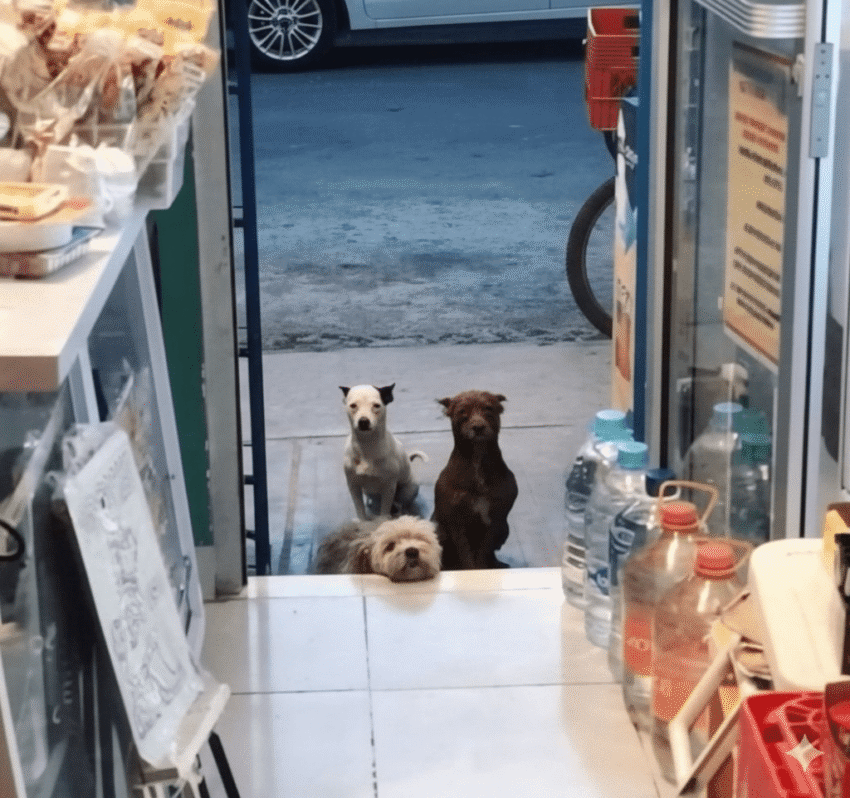The evening had begun like any other, the fluorescent glow of the convenience store cutting a sharp, inviting rectangle into the encroaching twilight. Inside, the familiar hum of refrigeration units and the neat, predictable rows of snacks and essentials offered a comforting illusion of order. But just beyond the threshold, where the sterile tile met the rough asphalt, three quiet shapes lingered. They were an almost imperceptible disruption to the urban rhythm, two dogs sitting alertly, their gazes fixed inward, and a third, smaller one, resting patiently, its chin almost touching the cool tiles.

No collars adorned their necks, no leashes hinted at ownership, yet they held a posture of profound understanding, respecting an invisible boundary that many humans often disregard. They were not begging, not barking, merely existing—a silent tableau against the backdrop of hurried passersby, most of whom barely registered their presence. This seemingly unremarkable scene, however, was about to become the unexpected prologue to a story that would unravel the hidden threads of compassion in a bustling city, challenging perceptions and ultimately, changing lives in ways no one could have foreseen.

Maria, the store owner, a woman whose face bore the lines of long hours and quiet resilience, was the first to truly notice them. Not just as “stray dogs” or a “problem,” but as individuals. For weeks, they had been a constant, if understated, presence. She’d tried shooing them away initially, a perfunctory gesture born more of habit than malice. But they would always return, never aggressive, never demanding, just watchful. Their eyes, she observed, held an almost human depth, a silent plea not for food, but for acknowledgment. One particularly chilly evening, as she was closing up, a sudden downpour caught her by surprise. She saw the three dogs huddle together, drenched but unmoving. A flicker of something akin to empathy stirred within her. She left a small, overturned box near the doorway, hoping it might offer a meager shelter, a subtle act of kindness she never mentioned to anyone.
The unexpected twist came not from the dogs, but from a customer. A young woman named Chloe, a budding photographer, had been captivated by the dogs’ stoic vigil. She started taking candid photos, observing their quiet interactions with the world and each other. One afternoon, she witnessed a scene that would alter the narrative entirely. A group of teenagers, seemingly intent on mischief, approached the dogs. Chloe braced herself for the worst, but instead, one of the dogs, the small fluffy one, stood up and slowly wagged its tail. The teenagers, taken aback by its gentle demeanor, hesitated. One of them, a boy with a surprisingly kind face, reached out a tentative hand. The dog licked it. Chloe captured the entire sequence, an unplanned moment of pure connection that challenged every preconceived notion about “strays.”

Chloe’s photographs, particularly the one of the teenager and the dog, quickly found their way onto local social media groups. The initial reaction was a mix of surprise and delight. People who had walked past the dogs for weeks, now saw them through a new lens. The image resonated, sparking conversations about empathy, judgment, and the hidden stories that unfold on city streets every day. Maria, initially wary of the attention, found her store becoming a focal point. People started stopping, not just to shop, but to ask about the “store dogs.” Some left small bowls of water, others offered gentle pats, respecting the dogs’ quiet space. The animals, in turn, seemed to thrive on this newfound, subtle recognition.

